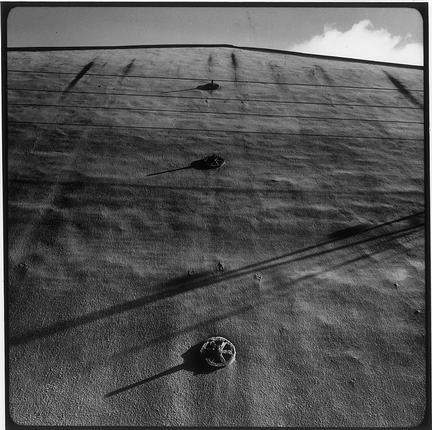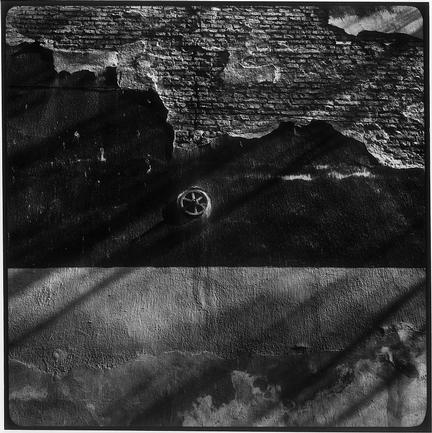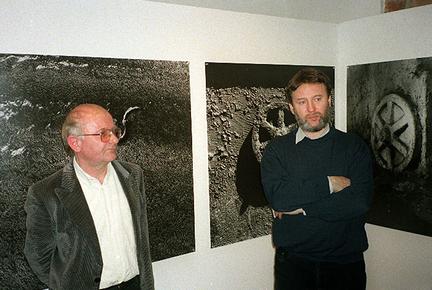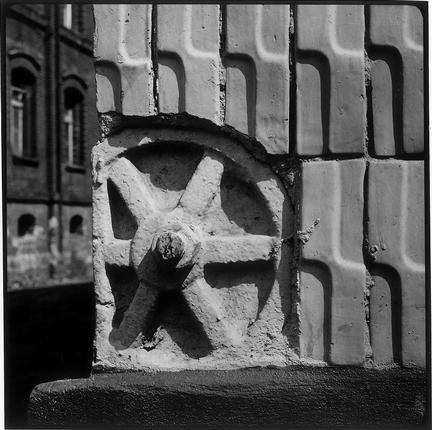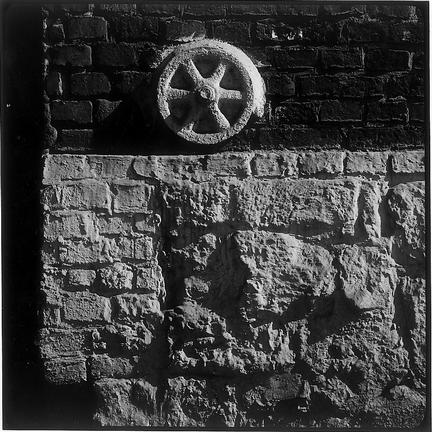Mala Gallery ZPAF-CSW
Warsaw, Pl. Zamkowy 8
February 1-25, 2000

Waldemar Jama: "Silesian chariots" - Mala Gallery, Warsaw, Poland, February 2000.
"Silesian Chariots" - an document?"
There is no truth beyond things - William Carlos Williams
The act of photographing is a particular case of intensifying the existence of human being in the world, it is an open contact. Revelation of the world in thousands of pictures tends towards to be composed into some sensibleness, compactness and continuity in time and space. - Urszula Czartoryska
The history of photography could be recapitulated as the struggle between two different imperatives: beautification, which comes from the fine arts, and truth-telling ...
There is a peculiar heroism abroad in the world since the invention of cameras: the heroism of vision. Photography opened up a new model of freelance activity - allowing each person to display a certain unique, avid sensibility. Susan Sontag, "On Photography"
EAL OBJECTS possesing magic power have to be distilled out of triviality of everyday images. Especially here in Silesia. Silesia is a mine of subject-matters. This is a region identified with grayness and mediocrity of life, industry and nothing interesting. This conglomerate of ambigous circumstances, cultural separateness, elusive socio-cultural melting pot of border line land nevertheless acccummulating energy of the world. I have chosen anchor-irons as a symbol of Silesia, which link together walls of buidings cracked because of earth tremors caused by crumps in mines. The source of inspiration was ordinary everyday life.
Anchor-iron - steel rod reinforcing construction elements / English - anchor / German - anker / Latin - ancora / Greek - ankyra.
1823 - begining of mining in the "Ferdynand" mine. 1845 - begining of mining in the "Kleofas" mine. Currently the both mines are joined together and named the "Katowice-Kleofas" mine.
Joining building walls with anchor-irons started in the early 20th century, about 1910 according to the staff of the State Service for Preservation of Monuments. Most of the photographs were taken in Katowice-Zaleze, the district that is above these mines.
Their endings are for me like wheels of chariots - the "Silesian chariots". An anchor-iron is not only a sign identyfying this place on Earth, it is a pictogram, a logo of certain towns-districts. It is more so (since there is more of them) than mine shafts. Here are collected images (of anchor-irons) simultanously (temporally) from different times and places. It widens the area of semantic possibilities.
The circle as the symbol of heaven represented in the Christian symbolics the DIVINE PERFECTION, the rosette symbolises gate of heaven (which reminds anchor-irons), the end of one world and emergence of the other in which the Sun is not needed anymore. Anyway, there is not much sunlight here in Silesia. Our faith in obviousness of reality vanishes but at the same time (according to Lyotard) "this endemic desire for reality" reminds us that what surrounds us in everyday life is frightfully real.
Here systematizing measure was taken. Its nature was to distinguish within one class the objects of one of more types - so it is typology as selection of the phenomenon. And this is what photography enables us to do. It brings to the light (reveals) obviousnesses not exhausted yet because, as S. Morawski writes: " ... of all possible mechnical means photography approaches most closely what we call objective reality".
The magic and documentary character of photography was noticed by conceptual art. Photography's features created possibility to go beyond aesthetizing and commercial model of art. An image was reduced to minimum, the whole weight was ascribed to conceptual content.
A concept, a project is suposed to come into existence in beholder's imagination. To make lasting art objects is apostasy from conceptual art. Reference to earlier achievements seems to be inevitable. I see some parallel in realisations of the German conceptual artists (Bernhard and Hilla Becher). They have been employing the simplest means when photographing cooling towers, mine shafts, etc. in Ruhr Valley in the late sixties. They created a kind of catalogue. Once ago Walter Benjamin called the collection of August Sander photographs an atlas.
In Poland conceptual art is present among artists for whom intelectualism is the basic and dominating element of art (eg. Z. Dlubak - Tautologies, Desymbolisations).
The presence of beauty in art is scarce now. Perhaps soon it will not be there anymore. By excluding the function and focusing on anchor-iron's form I can see some frozen, maltreated beauty. Frozen by time it was endowed with a new, different meaning. This reality is also an act of imagination. It is incessant coming into being - thanks to juxtaposing some number of their images. Professor A. Kepinska in her book "Photography - Reality of the Medium" published by the Academy of Fine Arts (ASP) in Poznan (1988) contained the text entitled "Reality - a vanishing category". After reading this the question remains; will we find some "chariots" ..., does everyone has to find his "chariot" ...?
S. Mallarme said long ago: "everything in this world exists to be photographed."
Waldemar Jama
.
Waldemar Jama: "Silesian chariots" - Mala Gallery, Warsaw, Poland, February 2000.
Waldemar Jama: "Silesian chariots" - Mala Gallery, Warsaw, Poland, February 2000.
HOTOGRAPHS of Waldemar Jama are always related to everyday life. It is the case when he transforms the old sepia toned images* from the past and when he reports on his near and far journeys. He is also recording on his perfectly composed and exposed photographs the elements of which our environment consists. Sometimes surrounded by the things we do not notice their existence.
Such newly discovered element in photographs of Waldemar Jama is anchor-iron, metal bar that fastens building constructions and is widely used in Silesia. Present on the walls of numerous homes it was „distinguished” by the photographer as one of most characteristic objects - symbols of the region.
This collection of photographs of the anchor-irons is kind of a challenge for the artist to deal with problem of representation of the real, not beautified picture of the world surrounding us. There is one simple principle for all these pictures - they show the endings of metal fastening devices. These endings show some variety within very rigorous entity. To reproduce the abundance of forms, different shapes and sizes Waldemar Jama uses very precisely the light, this basic tool of photography, changes perspective of individual photographs, creates atmosphere by emphasizing texture of the wall, shows various kinds of bricks and concrete. Thus he has created a whole gamut of changing background out of which individual anchor-irons emerge. They usually have shape of oval wheels reminding wheels of ancient chariots. It seems like that during centuries that passed the chariots have lost their wheels and now we have them in our industrial era. Waldemar Jama has found them embedded in walls of Silesian houses.
They are an important element of his daily life. Just in this everyday commonplacenes he has found an inspiration to record it in his photographs and to announce us their existence that is magic and real at the same time. Were it not for this collection we would not realize that they exist at all and how much they mean in artistic inquiries of Waldemar Jama.
Marek Grygiel
Artist Waldemar Jama (left) and curator Marek Grygiel - opening of Jama's exhibition in Mala Gallery, February 1st, 2000. Photo: Piotr Kubat /GW.
Waldemar Jama
born 1942
address: 40-877 Katowice, ul. Mieszka I 1/32
tel.: 1547942
Previous exhibitions in the Mala Gallery:
1992 - Podroze
1996 - Fantomy
Waldemar Jama: "Silesian chariots" - Mala Gallery, Warsaw, Poland, February 2000.
Waldemar Jama: "Silesian chariots" - Mala Gallery, Warsaw, Poland, February 2000.
Waldemar Jama: "Silesian chariots" - Mala Gallery, Warsaw, Poland, February 2000.
Copyright © 1997-2012 Marek Grygiel / Copyright for www edition © 1997-2012 Zeta-Media Inc.
e-mail: fti@zeta-media.com
